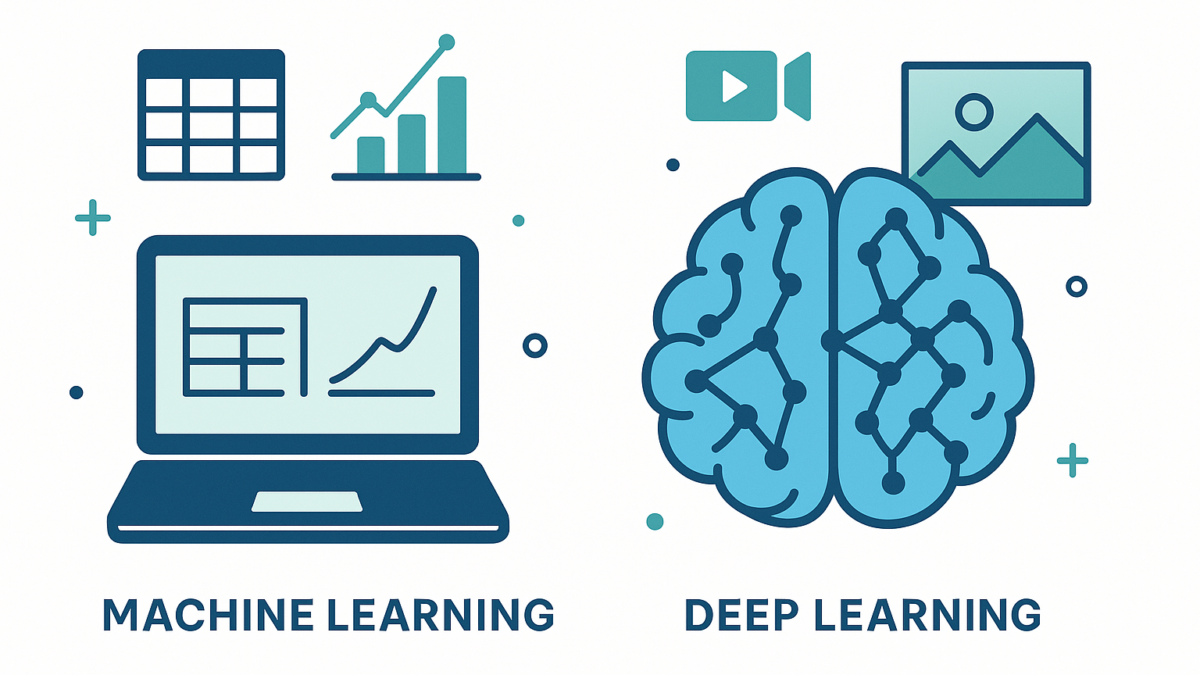Machine Learning vs Deep Learning: Key Differences & Real-World Applications
Table of Contents
Introduction
Artificial Intelligence (AI) is reshaping industries, and at its core are two transformative technologies: Machine Learning (ML) and Deep Learning (DL). Though often used interchangeably, they are distinct branches of AI with unique capabilities and applications. Understanding their differences is essential for businesses, developers, and decision-makers looking to implement AI-driven solutions.
In this blog, we’ll explore:
- What machine learning and deep learning mean
- Key differences between the two
- Use cases across industries
- Which one to choose for your business
- Future trends and predictions
What is Machine Learning?
Machine Learning is a subset of AI that enables systems to learn from data and improve performance without being explicitly programmed. Instead of using hard-coded rules, ML algorithms identify patterns and make predictions based on past data.
Key Characteristics:
- Works well with structured data
- Requires less computational power than deep learning
- Needs human intervention for feature selection and optimization
Common Machine Learning Algorithms:
- Linear Regression
- Decision Trees
- Random Forest
- Support Vector Machines (SVM)
- K-Nearest Neighbors (KNN)
Real-World Example:
Banks use ML algorithms to detect fraudulent transactions by analyzing spending patterns and flagging anomalies.
What is Deep Learning?
Deep Learning is a subset of ML that uses artificial neural networks designed to mimic the human brain. It automatically extracts features from raw data, enabling highly accurate models, especially with large datasets.
Key Characteristics:
- Ideal for unstructured data (images, audio, video, text)
- Requires large datasets and significant computing power (e.g., GPUs)
- Minimal human intervention required for feature engineering
Common Deep Learning Architectures:
- Convolutional Neural Networks (CNNs) – for image and video processing
- Recurrent Neural Networks (RNNs) – for sequential data like text
- Transformers – for NLP and language translation
- Autoencoders – for dimensionality reduction and anomaly detection
Real-World Example:
Autonomous vehicles like Tesla use deep learning to process live data from sensors and cameras to make real-time driving decisions.
Machine Learning vs Deep Learning: A Side-by-Side Comparison
| Feature | Machine Learning | Deep Learning |
|---|---|---|
| Data Dependency | Performs well with small data | Requires large datasets |
| Hardware Requirements | Low to moderate | High (needs GPUs/TPUs) |
| Feature Engineering | Manual feature selection | Automatic feature extraction |
| Training Time | Fast | Time-consuming |
| Accuracy | Moderate | High (with enough data) |
| Interpretability | Easier to interpret | Often a “black box” |
Use Cases Across Industries
Healthcare
- ML: Predicting patient readmissions
- DL: Diagnosing diseases through X-ray or MRI image analysis
Finance
- ML: Credit scoring and customer segmentation
- DL: High-frequency trading and sentiment analysis
Retail
- ML: Personalized marketing campaigns
- DL: Visual search (e.g., searching for products via images)
Entertainment
- ML: Recommendation systems (e.g., Netflix, Spotify)
- DL: Voice recognition and automatic content moderation
Which One Should You Choose?
The decision between machine learning and deep learning depends on:
- Data Volume:
- Use ML if you have limited, structured data.
- Use DL if you have large, unstructured data (images, video, audio).
- Accuracy vs Explainability:
- ML models are more interpretable.
- DL models offer higher accuracy but are harder to explain.
- Resources:
- ML models are lighter and cost-effective.
- DL requires heavy computational resources.
- Time to Market:
- ML can be deployed faster with lower training time.
- DL may take weeks or months to train and fine-tune.
📌 Pro Tip: Start with machine learning and scale to deep learning as your data and goals become more complex.
Future Outlook: Convergence of ML and DL
According to a report by Gartner, by 2026, over 75% of enterprises will shift from piloting AI to operationalizing it. The lines between ML and DL will blur as platforms offer hybrid models that combine the best of both worlds.
Also, the rise of AutoML and no-code AI platforms is democratizing access to both technologies, enabling non-experts to deploy powerful models at scale.
Conclusion
Machine learning and deep learning are not rivals but complementary tools in the AI toolbox. ML excels in simplicity and speed, while DL thrives in complexity and accuracy. Choosing the right one depends on your business goals, data infrastructure, and desired outcomes.
Looking to integrate AI into your business but unsure where to start?
Explore our AI development and consultation services to make data-driven decisions that scale.
You May Also Like: Top 7 Machine Learning Use Cases That Are Disrupting Industries in 2025





